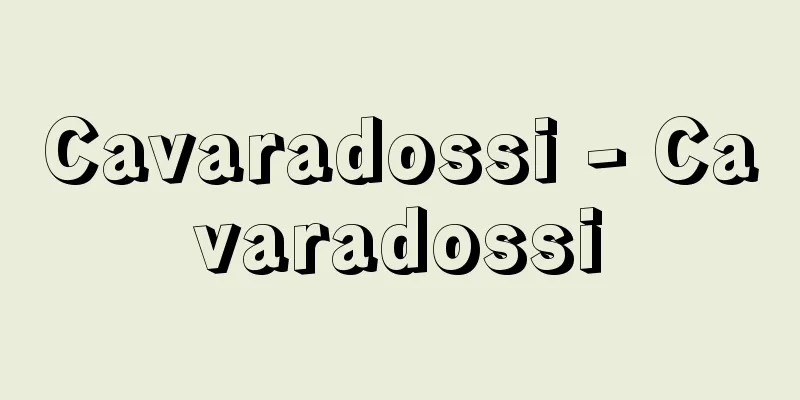Hanafuda cards

|
Also known as Hana Karuta, this is a typical Japanese karuta that stands alongside Western playing cards and Chinese mahjong tiles. It is also used as a gambling tool along with dice. [Kuramochi Sadasuke] historyHanafuda evolved from the Unsun Karuta, which was brought to Nagasaki by Dutch sailors during the Tensho period (1573-92), and was created and popular at the end of the Edo period. Before Hanafuda was created, there were Yomikaruta, Kingo Karuta, Kabu Karuta, Mekuri Karuta, etc., but the other karuta fell out of use and only Hanafuda is still popular today. The name Hanafuda is probably due to the flower patterns on them, but there is also a theory that it means that the Mekuri Karuta, which were popular before Hanafuda, were considered the main cards, and the Hanafuda are the replacements for them, such as Honban and Hanaban, Honzumo and Hanazumo. Hanafuda has 48 cards, divided into 12 months, and the cards' monthly classification and value are determined by the patterns on them. Hanafuda has a different card structure from Unsun Karuta and playing cards, with 12 types of cards in each set of four, and the higher-ranking cards are irregularly arranged among them. [Kuramochi Sadasuke] How to playThere are over 30 ways to play the game, including "Hachihachi," "Bakappana," "Hifumi," "Shigoro," "Inoshikacho," "Sanhyakuken," "Rokuhyakuken," "Koi-koi," and "Oicho-kabu." Among these, "Hachihachi" is the most common and widespread. [Kuramochi Sadasuke] Eight-eightThis game is usually played by three people. The total score of 264 points can be divided by three to get 88 points, hence the name. Up to six people can participate in the game. First, a dealer is chosen, who deals seven cards to each participant, then scatters six cards on the "table" (the center of the circle). The remaining cards are placed face down in a stack. Participants are free to play based on the quality of the cards they are dealt, or to quit (drop) by paying a set fee. However, if the three players starting from the dealer do not quit, the other participants drop out. Each game is played by three or two people. Starting with the dealer, players take turns putting one of their own cards onto the table, then flip over one of the remaining cards that are still in the table and match it with a card of the same pattern on the table. If there is no matching card, they simply put a card down. This is repeated until all the cards are gone, then the points of the cards each person has taken are calculated, and in the case of three players, the remaining points are calculated after subtracting 88 points, and in the case of two players, the difference between the points of the two players is the winning point. This is repeated 12 times. In Hachi-Hachi, in addition to the points earned, there are two other types of hands: hand hands that can be made from the cards dealt, and finished hands that can be made from the cards taken during the game. There are 12 types of hand hands, such as sanbon, red, short one, toichi, and light one, and a combination of two hand hands is called a kasane teyaku, of which there are 31 types. There are 15 types of finished hands, such as shikou, gokou, ameiri shikou, akatan, aozoratan, and sujuroku. If a finished hand is made during a match, the game can be ended immediately, in which case the points for the hand hand and finished hand are calculated. If a player continues playing despite making a finished hand, and then another person makes a finished hand and the game is ended, the previous finished hand will be penalized. The points for hand hands and finished hands vary slightly depending on the region, but can be decided among the players before the game begins. [Kuramochi Sadasuke] Oicho KabuA typical gambling game using Hanafuda cards. Before Hanafuda cards were invented, "kabu karuta" cards used exclusively for gambling were used. Forty Hanafuda cards are used, excluding the eight Ame and Kiri cards. The players are divided into a player and a customer (parent and child), and the player places three to five cards face up in front of the customer as hanging cards, and takes one card face down for himself. The customers look at the hanging cards and bet money as they wish. The player then deals one more card face down for the customers on which they have bet money, deals face up for the cards on which they have not bet money, and takes one card face down for himself. The player and the customer then start a game. The best score is 9, which is the maximum score possible when 10 or a multiple of the number of months on the two cards is subtracted. However, if the score is 6 or less, the player can receive one more card, and the score is calculated based on the total points of the three cards. If the player wins, he takes the customer's bet, but if he loses, he pays the customer the same amount as the customer's bet. Oicho Kabu has a unique way of reading the scores, with 8 being called oicho and 9 being called kabu, from which comes the name "Oicho Kabu." Hanafuda cards include cards that have been intricately crafted to look like cheats, known as "gan wo tsukeru" cards. These cards include "soguri cards," "gan with hair," "atsuusu cards," "rasusube cards," "naga cards," "hiro cards," and "shimigan cards," and are so intricately crafted that you can only tell if you look very closely. [Kuramochi Sadasuke] ©Shogakukan "> Hanafuda Card Types and Scoring Source: Shogakukan Encyclopedia Nipponica About Encyclopedia Nipponica Information | Legend |
|
花かるたともいい、欧米のトランプ、中国の麻雀牌(マージャンパイ)と並ぶ日本の代表的なかるた。さいころとともに賭(か)け事の用具としても使用されている。 [倉茂貞助] 歴史天正(てんしょう)年間(1573~92)オランダの水夫によって長崎に伝えられた「うんすんかるた」からしだいに変化し、江戸末期のころつくられ普及したものである。花札ができるまでは、読みかるた、金吾(きんご)かるた、かぶかるた、めくり札などがあったが、ほかのかるたは廃れ、花札だけが今日なお広く親しまれている。花札という名称は、花の絵模様が描かれているからであろうが、本番と花番、本相撲と花相撲というように、花札の前に流行しためくり札を本札とし、それにかわる花札という意味をとる説もある。花札は48枚で、12か月に分け、絵模様によって札の月別と価値を決めている。花札はうんすんかるたやトランプと札の構成が違い、12種類の札がそれぞれ4枚ずつで、そのなかに不規則に上級の札が配列されているところに特色がある。 [倉茂貞助] 遊び方「八八(はちはち)」「馬鹿花(ばかっぱな)」「一二三(ひふみ)」「四五六(しごろ)」「猪鹿蝶(いのしかちょう)」「三百けん」「六百けん」「こいこい」「おいちょかぶ」など30種を超える遊び方がある。なかでも「八八」が一般的でもっとも普及している。 [倉茂貞助] 八八この遊びは普通3人で行う。合計264点の点数を3で割ると88点になるところからこの名称が出ている。勝負に参加する人数は6人以内で、まず親を決め、親が参加者に7枚ずつ配り、「場(ば)」(円陣の中央)に6枚の札をまく。残り札は重ねて伏せて置く。参加者は、配られた札のよしあしで勝負するか、一定の降り賃を払ってやめる(落ちる)かは自由。ただし親から順に3人が勝負をやめないときは、他の参加者は勝負を降りる。各回の勝負は3人または2人で争う。方法は、親から順に自分の持ち札1枚を場に出し、さらに場に伏せたまま重ねて置いてある残り札を1枚めくり、ともに場にある同じ絵模様の札とあわせてとる。あわせる札がないときは、札を出すだけである。これを、持ち札が全部なくなるまで繰り返したのち、各人がとった札の点数を計算し、3人の場合は88点を差し引いた残りが、2人の場合は2人の点数の差が勝ち点となる。これを12回行う。 八八には、とった点数のほかに、配られた札のなかにできる手役(てやく)、勝負でとった札のなかにできる出来役の2種類の役がある。手役は、三本、赤、短(たん)一、十(と)一、光(ぴか)一など12種類で、二つの手役が組み合わされているのをかさね手役といい31種類ある。出来役は、四光(しこう)、五光、雨入四光、赤短、青短、素(す)十六など15種類ある。勝負の途中で出来役ができたときは、ただちに勝負を打ち切ることができ、その場合は手役と出来役の点数を計算する。出来役ができても勝負を打ち切らず続ける場合、その後にほかの人に出来役ができて勝負を打ち切られると、前の出来役は自分の減点となる。手役と出来役の点数は、地方によって多少違うが、勝負を始める前に参加者の間で決めておけばよい。 [倉茂貞助] おいちょかぶ花札を使用する代表的な賭け事。花札ができる前は、「かぶかるた」という賭け事専用の札が使われていた。花札のうち雨と桐8枚を除いた40枚を使う。胴と客(親と子)に分かれ、胴は客の前に張り札として3ないし5枚の札を表を出して並べ、自分は伏せて1枚の札をとる。客は張り札を見て思い思いに金銭を賭ける。胴はさらに1枚ずつ、客が金銭を賭けているところは伏せて配り、金銭を賭けられてないところは表を出して配り、自分も伏せたまま1枚をとる。そこで胴と客とが勝負になる。2枚の札の月数の合計から10またはその倍数を差し引いて残りが9となるのを最高とする。ただ点数が6以下のときは、さらに1枚の札をもらうことができ、3枚の合計点で計算する。勝負の結果、胴が勝てば客の賭け金をとり、負ければ客の賭け金と同額をその客に支払う。おいちょかぶは点数の読み方が独特で、8をオイチョ、9をカブというところから「おいちょかぶ」の名称が出ている。 花札には「がんをつける」といって、いかさまの細工を施してある札がある。「そぐり札」「毛入りがん」「あつうす札」「ざらすべ札」「長札」「広札」「しみがん」などがあり、よほど注意して見なければわからないほど精巧にできている。 [倉茂貞助] ©Shogakukan"> 花札の札の種類と得点 出典 小学館 日本大百科全書(ニッポニカ)日本大百科全書(ニッポニカ)について 情報 | 凡例 |
Recommend
Symons, Arthur (William)
Born: 28 February 1865, Milford Haven, Pembrokeshi...
Chewing betel nuts
...But in agricultural cultures, intoxicating foo...
Cued Speech - Cued Speech
... Since the 1960s, oral speech has been reexami...
Tomobiki - Tomobiki
〘Noun〙① According to the theory of Onmyou, the dir...
Gold glitter - kinrame
...A woven fabric with a pattern created using go...
Yoshitoshi Tsukioka
An ukiyo-e artist from the late Edo to the Meiji ...
Invert soap - invert soap
Another name for cationic surfactants. Unlike anio...
Humanistic Law - Jinbunshugihokku
A school of Roman law research that flourished mai...
MIS (English abbreviation) Management Information System
Management information system. A system for collec...
Erik IX
...During this primitive tribal period, Finland b...
Convergence - Shuren (English spelling) convergence
This refers to the independent evolution of organ ...
Keiichiro Saori
1870 * - 1943 A stage actor from the Meiji to ear...
Ichiinkai - Ichiinkai
...The Four-Inlay Mandala above the memorial serv...
Rondelet, G. (English spelling) RondeletG
…Italian naturalist. Born in Bologna to an aristo...
Floating Woman - Ukareme
A woman who entertains people by singing and danci...









